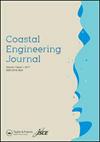A new predictive equation for estimating wave period of subaerial solid-block landslide-generated waves
IF 1.9
3区 工程技术
Q3 ENGINEERING, CIVIL
引用次数: 1
Abstract
ABSTRACT In the aftermath of the deadly 2018 Anak Krakatau tsunami (Indonesia) and associated confusions over its modeling and generation mechanism, there has been an urgent need for further studies to improve our understanding of landslide-generated tsunamis. Two important factors in accurate modeling of landslide tsunamis are the wave period and the initial wave amplitude. Here, we apply a physical modeling approach and develop an empirical equation to predict the dominant wave period generated by solid-block subaerial landslide tsunamis. Fifty-one laboratory experiments are conducted at different water depths and using four different concrete blocks for the sliding masses. The results are consequently employed to derive a predictive equation for the wave period of solid-block subaerial landslide tsunamis. An innovation of this study is that we apply data from different scales (laboratory and field scales) to produce our predictive equation. For field data, the data from the 2018 Anak Krakatau event is used. We compared our predictive equation with other previously-published equations. To confirm the validity of our predictive equation, it is applied for the prediction of the wave period of an independent landslide tsunami event whose data was not used for the derivation of the equation.一种估算陆上固体块体滑坡波周期的新预测方程
2018年印尼喀拉喀托阿纳克海啸发生后,人们对其建模和产生机制存在诸多困惑,迫切需要进一步研究以提高我们对滑坡引发的海啸的认识。准确模拟滑坡海啸的两个重要因素是波周期和初始波幅。在这里,我们采用物理模拟方法,并开发了一个经验方程来预测固体块体陆上滑坡海啸产生的主导波周期。在不同的水深和使用四种不同的混凝土块作为滑动块进行了51个实验室实验。结果可用于推导固体块体陆上滑坡海啸波周期的预测方程。这项研究的一个创新之处在于,我们应用了来自不同尺度(实验室和现场尺度)的数据来产生我们的预测方程。对于现场数据,使用2018年喀拉喀托火山事件的数据。我们将我们的预测方程与之前发表的其他方程进行了比较。为了验证该预测方程的有效性,将其应用于一次独立滑坡海啸事件的波周期预测,该事件的数据未用于方程的推导。
本文章由计算机程序翻译,如有差异,请以英文原文为准。
求助全文
约1分钟内获得全文
求助全文
来源期刊

Coastal Engineering Journal
工程技术-工程:大洋
CiteScore
4.60
自引率
8.30%
发文量
0
审稿时长
7.5 months
期刊介绍:
Coastal Engineering Journal is a peer-reviewed medium for the publication of research achievements and engineering practices in the fields of coastal, harbor and offshore engineering. The CEJ editors welcome original papers and comprehensive reviews on waves and currents, sediment motion and morphodynamics, as well as on structures and facilities. Reports on conceptual developments and predictive methods of environmental processes are also published. Topics also include hard and soft technologies related to coastal zone development, shore protection, and prevention or mitigation of coastal disasters. The journal is intended to cover not only fundamental studies on analytical models, numerical computation and laboratory experiments, but also results of field measurements and case studies of real projects.
 求助内容:
求助内容: 应助结果提醒方式:
应助结果提醒方式:


